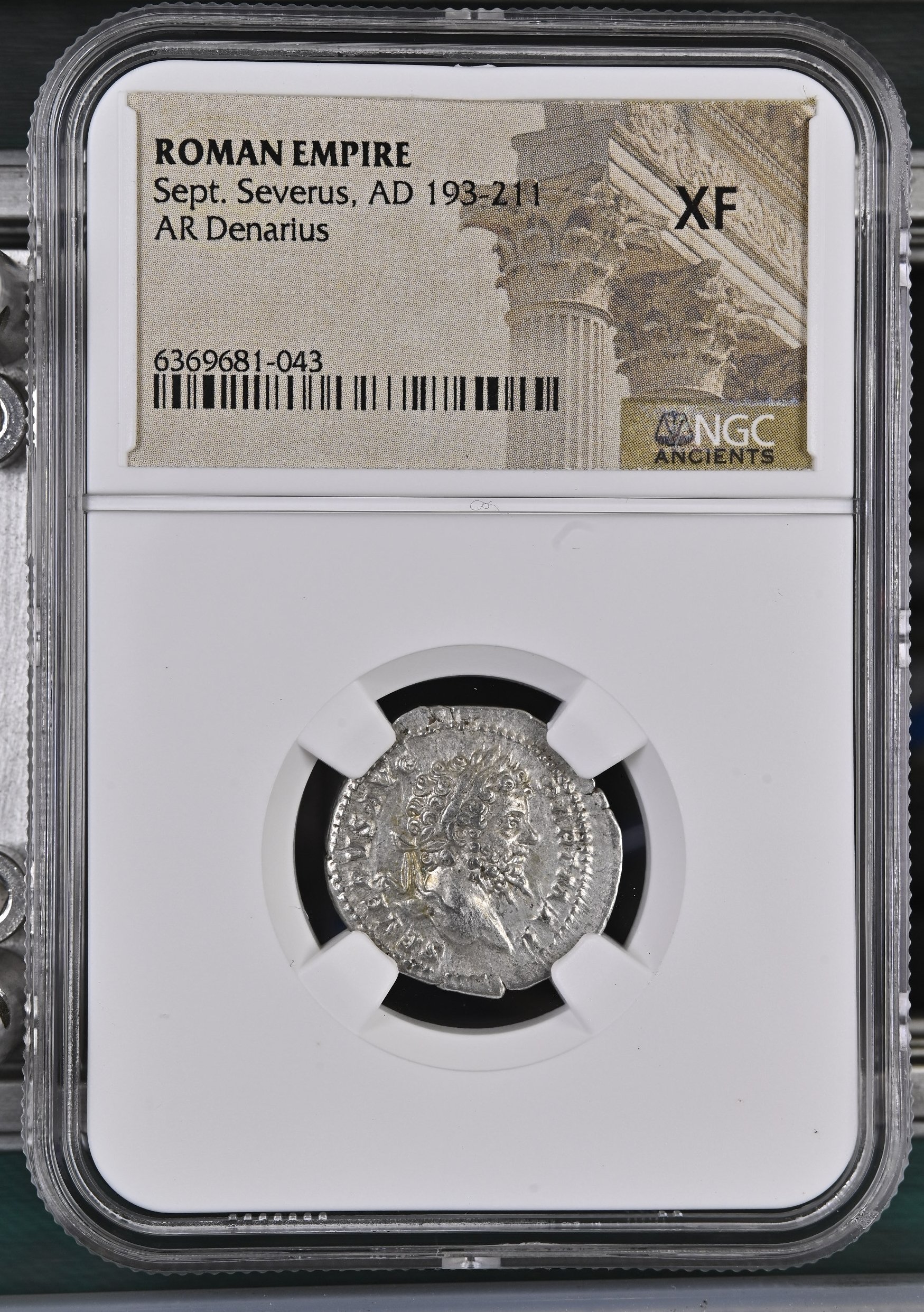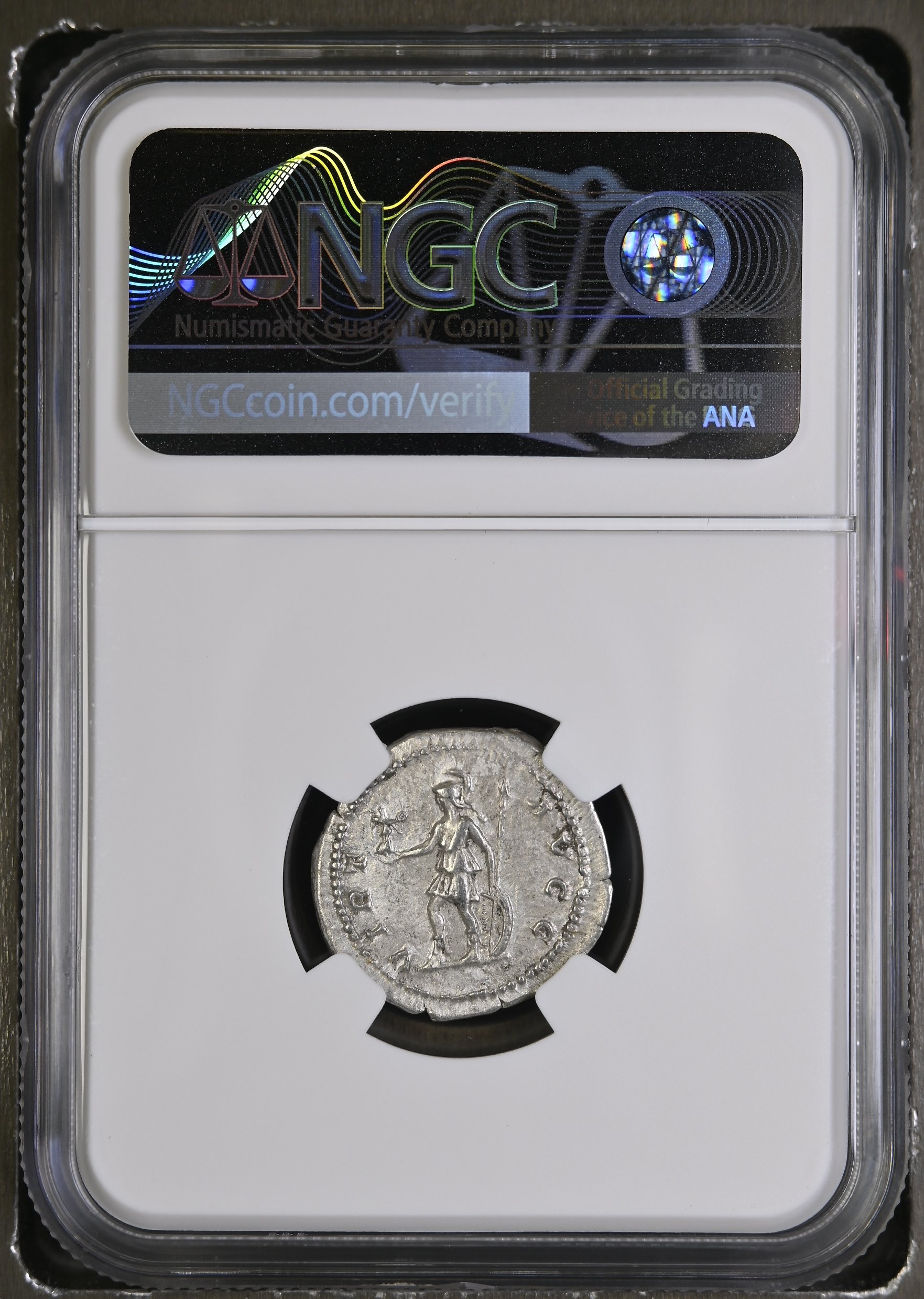 Image 1 of 2
Image 1 of 2

 Image 2 of 2
Image 2 of 2



Silver Denarius of Septimius Severus (about 1,800 years ago)
This coin is a silver denarius issued during the reign of Emperor Septimius Severus, who ruled the Roman Empire from 193 to 211 CE. As founder of the Severan dynasty, Septimius Severus came to power following the tumultuous "Year of the Five Emperors" and established a military monarchy that would influence Roman governance for generations. This particular example represents the standard silver currency of the empire during a period of significant military campaigns and imperial expansion.
Coin Description:
Front side: The obverse likely displays the laureate (wreath-crowned) bust of Emperor Septimius Severus facing right, with his characteristic beard and stern expression. The surrounding Latin inscription would state his name and titles.
Back side: Though not specified, the reverse would typically depict either a Roman deity, personification of a virtue, military victory scene, or other symbolic imagery relevant to Severus' reign, accompanied by appropriate inscriptions.
Technical Details:
Silver composition (abbreviated as AR, from Latin "argentum" meaning silver)
Denarius denomination (the standard silver coin of the Roman monetary system)
Weight: Approximately 3-3.5 grams (typical for denarii of this period)
Size: Approximately 18-20mm in diameter
NGC Grade: XF (Extremely Fine) - indicating excellent preservation with minor wear, clear details
Date of minting: 193-211 CE (during Septimius Severus' reign)
Historical Significance: This denarius was minted during a transformative period in Roman history. Septimius Severus, born in Leptis Magna (modern Libya), was the first African-born emperor and rose to power after a brief civil war. His rule marked an increasing reliance on the military for imperial power, with significant campaigns in Britain, Parthia, and along the empire's frontiers. During his reign, the silver content of the denarius was slightly reduced to help finance his military campaigns, illustrating the economic pressures of maintaining the vast empire. A denarius represented approximately a day's wages for the average Roman laborer and would have been used in everyday transactions throughout the empire, from Britannia (Britain) to Mesopotamia (Iraq). Coins like this served not only as currency but as propaganda tools, spreading the emperor's image and achievements to the furthest reaches of Roman territory.
This coin is a silver denarius issued during the reign of Emperor Septimius Severus, who ruled the Roman Empire from 193 to 211 CE. As founder of the Severan dynasty, Septimius Severus came to power following the tumultuous "Year of the Five Emperors" and established a military monarchy that would influence Roman governance for generations. This particular example represents the standard silver currency of the empire during a period of significant military campaigns and imperial expansion.
Coin Description:
Front side: The obverse likely displays the laureate (wreath-crowned) bust of Emperor Septimius Severus facing right, with his characteristic beard and stern expression. The surrounding Latin inscription would state his name and titles.
Back side: Though not specified, the reverse would typically depict either a Roman deity, personification of a virtue, military victory scene, or other symbolic imagery relevant to Severus' reign, accompanied by appropriate inscriptions.
Technical Details:
Silver composition (abbreviated as AR, from Latin "argentum" meaning silver)
Denarius denomination (the standard silver coin of the Roman monetary system)
Weight: Approximately 3-3.5 grams (typical for denarii of this period)
Size: Approximately 18-20mm in diameter
NGC Grade: XF (Extremely Fine) - indicating excellent preservation with minor wear, clear details
Date of minting: 193-211 CE (during Septimius Severus' reign)
Historical Significance: This denarius was minted during a transformative period in Roman history. Septimius Severus, born in Leptis Magna (modern Libya), was the first African-born emperor and rose to power after a brief civil war. His rule marked an increasing reliance on the military for imperial power, with significant campaigns in Britain, Parthia, and along the empire's frontiers. During his reign, the silver content of the denarius was slightly reduced to help finance his military campaigns, illustrating the economic pressures of maintaining the vast empire. A denarius represented approximately a day's wages for the average Roman laborer and would have been used in everyday transactions throughout the empire, from Britannia (Britain) to Mesopotamia (Iraq). Coins like this served not only as currency but as propaganda tools, spreading the emperor's image and achievements to the furthest reaches of Roman territory.
This coin is a silver denarius issued during the reign of Emperor Septimius Severus, who ruled the Roman Empire from 193 to 211 CE. As founder of the Severan dynasty, Septimius Severus came to power following the tumultuous "Year of the Five Emperors" and established a military monarchy that would influence Roman governance for generations. This particular example represents the standard silver currency of the empire during a period of significant military campaigns and imperial expansion.
Coin Description:
Front side: The obverse likely displays the laureate (wreath-crowned) bust of Emperor Septimius Severus facing right, with his characteristic beard and stern expression. The surrounding Latin inscription would state his name and titles.
Back side: Though not specified, the reverse would typically depict either a Roman deity, personification of a virtue, military victory scene, or other symbolic imagery relevant to Severus' reign, accompanied by appropriate inscriptions.
Technical Details:
Silver composition (abbreviated as AR, from Latin "argentum" meaning silver)
Denarius denomination (the standard silver coin of the Roman monetary system)
Weight: Approximately 3-3.5 grams (typical for denarii of this period)
Size: Approximately 18-20mm in diameter
NGC Grade: XF (Extremely Fine) - indicating excellent preservation with minor wear, clear details
Date of minting: 193-211 CE (during Septimius Severus' reign)
Historical Significance: This denarius was minted during a transformative period in Roman history. Septimius Severus, born in Leptis Magna (modern Libya), was the first African-born emperor and rose to power after a brief civil war. His rule marked an increasing reliance on the military for imperial power, with significant campaigns in Britain, Parthia, and along the empire's frontiers. During his reign, the silver content of the denarius was slightly reduced to help finance his military campaigns, illustrating the economic pressures of maintaining the vast empire. A denarius represented approximately a day's wages for the average Roman laborer and would have been used in everyday transactions throughout the empire, from Britannia (Britain) to Mesopotamia (Iraq). Coins like this served not only as currency but as propaganda tools, spreading the emperor's image and achievements to the furthest reaches of Roman territory.
Lucius Septimius Severus (/səˈvɪərəs/;[5] Latin: [ˈɫuːkiʊs sɛpˈtɪmiʊs sɛˈweːrʊs]; 11 April 145 – 4 February 211) was Roman emperor from 193 to 211. He was born in Leptis Magna (present-day Al-Khums, Libya) in the Roman province of Africa.[6][7] As a young man he advanced through the customary succession of offices under the reigns of Marcus Aurelius and Commodus. Severus was the final contender to seize power after the death of the emperor Pertinax in 193 during the Year of the Five Emperors.
After deposing and killing the incumbent emperor Didius Julianus, Severus fought his rival claimants, the Roman generals Pescennius Niger and Clodius Albinus. Niger was defeated in 194 at the Battle of Issus in Cilicia. Later that year Severus waged a short punitive campaign beyond the eastern frontier, annexing the Kingdom of Osroene as a new province. Severus defeated Albinus three years later at the Battle of Lugdunum in Gaul. Following the consolidation of his rule over the western provinces, Severus waged another brief, more successful war in the east against the Parthian Empire, sacking their capital Ctesiphon in 197 and expanding the eastern frontier to the Tigris. He then enlarged and fortified the Limes Arabicus in Arabia Petraea. In 202, he campaigned in Africa and Mauretania against the Garamantes, capturing their capital Garama, and expanding the Limes Tripolitanus along the southern desert frontier of the empire.





















